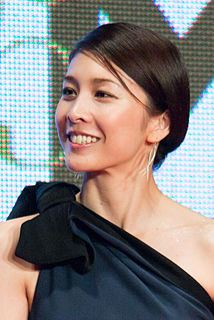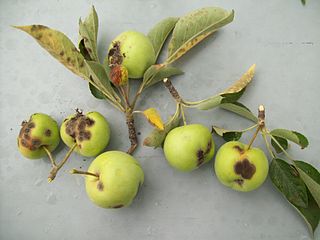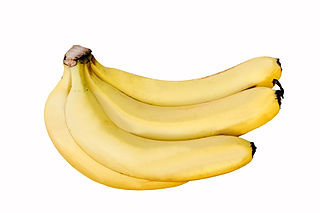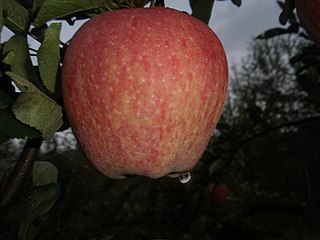
This is a list of Japanese apple cultivars which includes apple cultivars, as well as hybrid cultivars, invented in Japan.

This is a list of Japanese apple cultivars which includes apple cultivars, as well as hybrid cultivars, invented in Japan.

The persimmon is the edible fruit of a number of species of trees in the genus Diospyros. The most widely cultivated of these is the Oriental persimmon, Diospyros kaki – among the most commonly human-grown fruit trees on Earth. Diospyros is in the family Ebenaceae, and a number of non-persimmon species of the genus are grown for ebony timber. In 2019, China produced 75% of the world total of persimmons.
Cauliflower is one of several vegetables in the species Brassica oleracea in the genus Brassica, which is in the Brassicaceae family. It is an annual plant that reproduces by seed. Typically, only the head is eaten – the edible white flesh sometimes called "curd". The cauliflower head is composed of a white inflorescence meristem. Cauliflower heads resemble those in broccoli, which differs in having flower buds as the edible portion. Brassica oleracea also includes broccoli, Brussels sprouts, cabbage, collard greens, and kale, collectively called "cole" crops, though they are of different cultivar groups.

The mandarin orange, also known as the mandarin or mandarine, is a small citrus tree fruit. Treated as a distinct species of orange, it is usually eaten plain or in fruit salads. Tangerines are a group of orange-coloured citrus fruit consisting of hybrids of mandarin orange with some pomelo contribution.

'Golden Delicious' is a cultivar of apple. It is one of the 15 most popular cultivars in the United States. It is not closely related to 'Red Delicious'.

Pollination of fruit trees is required to produce seeds with surrounding fruit. It is the process of moving pollen from the anther to the stigma, either in the same flower or in another flower. Some tree species, including many fruit trees, do not produce fruit from self-pollination, so pollinizer trees are planted in orchards.

Yūko Takeuchi was a Japanese actress. She is known for her roles in television series Asuka (1999), Pride (2004), FlashForward (2009), and Miss Sherlock (2018) as well as films such as Ring (1998), Yomigaeri (2003), and Dog in a Sidecar (2007).

Apple scab is a common disease of plants in the rose family (Rosaceae) that is caused by the ascomycete fungus Venturia inaequalis. While this disease affects several plant genera, including Sorbus, Cotoneaster, and Pyrus, it is most commonly associated with the infection of Malus trees, including species of flowering crabapple, as well as cultivated apple. The first symptoms of this disease are found in the foliage, blossoms, and developing fruits of affected trees, which develop dark, irregularly-shaped lesions upon infection. Although apple scab rarely kills its host, infection typically leads to fruit deformation and premature leaf and fruit drop, which enhance the susceptibility of the host plant to abiotic stress and secondary infection. The reduction of fruit quality and yield may result in crop losses of up to 70%, posing a significant threat to the profitability of apple producers. To reduce scab-related yield losses, growers often combine preventive practices, including sanitation and resistance breeding, with reactive measures, such as targeted fungicide or biocontrol treatments, to prevent the incidence and spread of apple scab in their crops.

Cavendish bananas are the fruits of one of a number of banana cultivars belonging to the Cavendish subgroup of the AAA banana cultivar group. The same term is also used to describe the plants on which the bananas grow.

The Japanese elm cultivar Ulmus davidianavar.japonica 'Prospector' was originally treated as a cultivar of Wilson's elm U. wilsonianaSchneid., a species sunk as Ulmus davidiana var. japonica by Fu. A U.S. National Arboretum introduction, it was selected in 1975 from a batch of 1965 seedlings in Delaware, Ohio, and released without patent restrictions in 1990. 'Prospector' proved moderately successful in the US National Elm Trial, averaging a survival rate of 76% overall.

Prunus × yedoensis is a hybrid cherry between Prunus speciosa as father plant and Prunus pendula f. ascendens as mother. It is a hybrid born in Japan and one of its cultivars, Prunus × yedoensis 'Somei-yoshino' or Yoshino cherry, is one of the most popular and widely planted cherry cultivars in temperate regions around the world today. 'Somei-yoshino' is a clone from a single tree, and has been propagated by grafting all over the world. 'Somei-yoshino' inherits Edohigan's quality of blooming before the leaves unfold and it growing into a large-sized tree. It also inherits the characteristics of the Oshima zakura, which grows rapidly and has white flowers. These characteristics are favored and have become one of the most popular cultivars of cherry trees.

Anthocyanins are water-soluble vacuolar pigments that, depending on their pH, may appear red, purple, blue, or black. In 1835, the German pharmacist Ludwig Clamor Marquart gave the name Anthokyan to a chemical compound that gives flowers a blue color for the first time in his treatise “Die Farben der Blüthen”. Food plants rich in anthocyanins include the blueberry, raspberry, black rice, and black soybean, among many others that are red, blue, purple, or black. Some of the colors of autumn leaves are derived from anthocyanins.

An apple is an edible fruit produced by an apple tree. Apple trees are cultivated worldwide and are the most widely grown species in the genus Malus. The tree originated in Central Asia, where its wild ancestor, Malus sieversii, is still found today. Apples have been grown for thousands of years in Asia and Europe and were brought to North America by European colonists. Apples have religious and mythological significance in many cultures, including Norse, Greek, and European Christian tradition.

Cider is an alcoholic beverage made from the fermented juice of apples. Cider is widely available in the United Kingdom and the Republic of Ireland. The UK has the world's highest per capita consumption, as well as the largest cider-producing companies. Ciders from the South West of England are generally stronger. Cider is also popular in many Commonwealth countries, such as India, Canada, Australia, and New Zealand. As well as the UK and its former colonies, cider is popular in Portugal, France, northern Italy, and northern Spain. Central Europe also has its own types of cider with Rhineland-Palatinate and Hesse producing a particularly tart version known as Apfelwein. In the U.S., varieties of fermented cider are often called hard cider to distinguish alcoholic cider from non-alcoholic apple cider or "sweet cider", also made from apples. In Canada, cider cannot contain less than 2.5% or over 13% absolute alcohol by volume.

Sweet Blue Flowers is a Japanese yuri manga series written and illustrated by Takako Shimura. It was serialized between November 2004 and July 2013 in Ohta Publishing's Manga Erotics F manga magazine and is licensed in English by Viz Media. Eight volumes were published between December 2005 and September 2013. The story focuses on Fumi Manjōme, a lesbian high school girl, and her close childhood friend Akira Okudaira, who tries to keep her friends happy through difficult times.
Star Wolf is a Japanese science fiction TV series inspired by the novel series of the same name, by American writer Edmond Hamilton. It was produced in 1978 by Tsuburaya Productions.

Plant breeding is the science of changing the traits of plants in order to produce desired characteristics. It has been used to improve the quality of nutrition in products for humans and animals. The goals of plant breeding are to produce crop varieties that boast unique and superior traits for a variety of agricultural applications. The most frequently addressed traits are those related to biotic and abiotic stress tolerance, grain or biomass yield, end-use quality characteristics such as taste or the concentrations of specific biological molecules and ease of processing.
Plant breeding started with sedentary agriculture, particularly the domestication of the first agricultural plants, a practice which is estimated to date back 9,000 to 11,000 years. Initially, early human farmers selected food plants with particular desirable characteristics and used these as a seed source for subsequent generations, resulting in an accumulation of characteristics over time. In time however, experiments began with deliberate hybridization, the science and understanding of which was greatly enhanced by the work of Gregor Mendel. Mendel's work ultimately led to the new science of genetics. Modern plant breeding is applied genetics, but its scientific basis is broader, covering molecular biology, cytology, systematics, physiology, pathology, entomology, chemistry, and statistics (biometrics). It has also developed its own technology. Plant breeding efforts are divided into a number of different historical landmarks.

Prunus simonii, called apricot plum and Simon plum, is a tree in the genus Prunus. It was first described by Elie-Abel Carrière in 1872 and is native to Hebei province, China. The species is not known in a truly wild state. It has been important for breeding commercial plum cultivars from crosses with other species of the genus Prunus. The species is named for Gabriel Eugène Simon (1829–1896), a French botanist and diplomat who sent pits to the Paris Museum in the early 1860s while he was representing the French government in China. Beginning about 1881, the species became commonly known in the United States; having been introduced there from France.

Huaniu, also known as Chinese Red Delicious is an apple cultivar originating from China. It is named after Huaniu town, Tianshui, where it was first planted as a hybrid of 10 varieties of apple trees, including Red Delicious, Golden Delicious and Ralls Janet in 1956. In 1965, Huaniu farmers sent two boxes of apples to Chairman Mao to express their respect for him. Mao thanked the villagers, noting that he was very fond of the apple's taste. That same year, the apples were exported to Hong Kong. The name of the village of Huaniu was put on the box, and the apples were preferred over the US imported Red Delicious. Since then, Huaniu apples have been well known in China. The apple has a sweet taste comparable with Fuji apples. The apples have a soluble solid contents of 12.5-14%, sugar content of 1.86%, and malic acid content of 0.08%.
'Toki', released several years prior to its registration in 2004, is a juicy and very sweet yellow cultivar whose production is rapidly increasing.